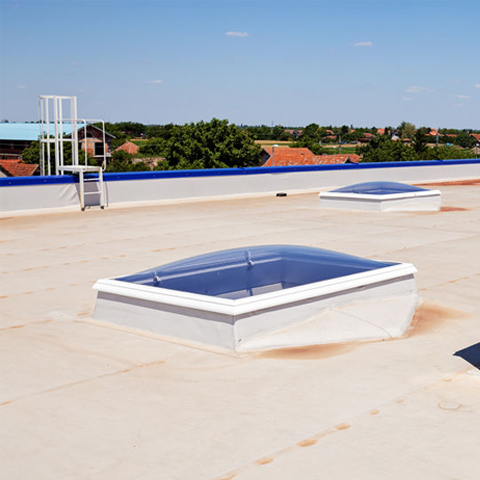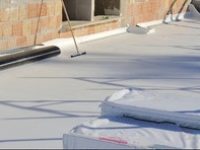How can I make my roof last longer?
To get the most of your commercial roof, preventative maintenance is a must. Any commercial building manager or commercial building owner should have a commercial roof maintenance plan with a commercial roof maintenance checklist, making sure that they follow them each week, month, all year as stated. Commercial roof maintenance is necessary in order to catch any issue before it becomes a costly expense and interruptive process.
Commercial roofing professionals advise that while some roofing materials last longer than others, the lifespan of any roof is based on averages. Here are some commercial roof maintenance tips that will help you get the best and longest performance from your roof.
Suitable design
Years are added to the life of a commercial building’s roof when the building and the roof have a suitable design. From proper sizing structural members and careful consideration of penetration details to selecting the right roof type at the start of a construction project is a must, followed up by consistent and proper commercial roof maintenance.
Adequate ventilation
Just as the roof on your home needs proper ventilation, so does a commercial building’s roof. The roof level needs good airflow to stay cool in the summer and warm in the winter. Proper ventilation prevents moisture build-up and eliminates mold. An experienced commercial building HVAC engineer and technician will ensure the airflow is adequate during an annual inspection, which should be a part of your own commercial roof maintenance plan.
Routine maintenance
Too often, building maintenance is taken for granted, but when it comes to commercial roof maintenance, that should never be ignored. Every commercial building should have a roof that is accessible so that the organization of the HVAC and plumbing systems is kept up and any roof repairs are addressed promptly.
The material and method
There are as many commercial roof types as there are ways to perform commercial roof maintenance. It can be confusing to choose the right roof type. The climate, the location, and the cost should all be carefully considered. For a flat roof application, the BUR (built-up roofs) makes good sense for regions with little rain. Today, sustainability is a driving force for energy savings and ROI over the roof’s lifetime. Commercial building owners should take advantage of sustainability incentives in making their commercial roof decisions.
The warranty
There are many types of roofing warranties, usually one for defects of actual materials and one for workmanship. Choose a reputable commercial roofing company to work with so you know you’re getting the best. One aspect they all have in common is property commercial roof maintenance must be done in order for the warranty to be honored.
What does roof maintenance include?
The roof system of any structure is a vulnerable part of the exterior with hail, ice, rain, sleet, snow, UV rays, and more attacking it 24/7/365 at some point. It bases good performance of a commercial roof is on the design, the materials, proper installation, and commercial roof maintenance. This is critical to avoid roof problems that can be expensive and intrusive. A watertight condition is a must and early identification of problems, followed up by prompt repair will give your commercial roof a longer lifespan.
Start by forming an in-house commercial roof maintenance program, with budgeting for outside commercial roofing professionals for some aspects that company personnel isn’t experienced are trained in performing.
The in-house team will be responsible for the basic maintenance items, like keeping the roof clean of debris. When debris is left alone, it can block the roof drains and cause ponding, one of the biggest damages causing issues of commercial roofs. Building maintenance should minimize roof foot traffic and when it is necessary for HVAC or plumbing matters, proper membrane protection must be in place with roof pavers or walkway pads.
A suggested checklist for commercial roof maintenance:
- Interior Signs: Once a month, commercial roof maintenance examination should begin with the interior for signs of drips and leaks, look for mildew, mold, peeling paint, water stains on the interior. If you discover any, do a roof inspection or schedule a professional commercial roofing contractor. If your building is in areas where high amounts of snow may happen, or if there is heavy equipment on the roof, an annual inspection of beams and trusses for any cracking, rot, or rust is recommended.
- Cleanliness: While on the rooftop doing an inspection, look for an accumulation of dirt and debris and remove them. These will clog roof drains, cause ponding, which will decay or rot the roof. Remove any tree limbs and check for possible roof membrane damage. If trees are a constant problem, schedule a tree trimming service.
- Roof Surface: During your commercial roof maintenance inspection, check for damage or weathering, like the low spot on a flat roof, where water is notorious for collecting. Look for blistering, cracking, deep scratches, holes, or tears in the membrane. For a gravel-top roof, make sure the gravel is uniformly layered and free of empty spots. For commercial metal roofs, your commercial roof maintenance inspection should include looking for corrosion and damaged or loose panels. Tile and shingle commercial roofs include looking for damaged, loose, or missing pieces. If you find any fungus or moss growing, schedule a commercial roof cleaning to remove it before they deteriorate the roof surface.
- The Expansion Joints and Flashings: Your commercial roof maintenance inspections should include looking for cuts, gaps, and tears. Check the flashings around the skylights, HVAC, and plumbing vent pipes.
- The Drains and Exterior Elements: Make sure the drains are clear of debris, limbs, mold, and moss. All the chimneys, pipes, skylights, vents, and other equipment should be inspected for cleanliness, fungus, moss, peeling paint, rot, rust, and rot and damaged or missing parts.
- Railing and Stairs: Your inspection for commercial roof maintenance should include checking the crossovers, platforms, railings, and stairs for loose parts, making sure they are solid and sound.
- Safety Signs: Make sure all required signs are in place, legible, and in a prominent view.
- Verify Old Repairs: Confirm that previous repairs are still in good condition during your scheduled commercial roof maintenance.
Should I get my roof inspected?
If you aren’t sure of the commercial roof maintenance history or when the last inspection was performed, then yes, schedule one with an experienced commercial roofing company. From there, the frequency of when to have a roof inspection will depend on several factors, starting with the age of the roof. The geographic area and weather are factors that will determine the frequency. A roof inspection is important to the integrity of your building and the life of the roof.
How much does it cost to have a roof inspected?
There is not a set fee for a commercial roof inspection, but the average rate will start around $200 and can go up to $1,000 or more. There are different factors involved in roof inspection, such as height, levels, square footage, and difficulty doing the inspection, such as fixing the roof to walk on it for the inspection.
What do roof inspectors look for?
A commercial roof inspector will check for leaks, damage, unusual wear and tear, and organic growth issues such as mildew and moss. They check for any problems with the installation of roofing materials and any repairs that have been done. As an owner or manager of a commercial building, because there have been no problems brought to your attention, you should not overlook an inspection. As we mentioned in this piece, your diligence in inspecting will help in avoiding unplanned expenses later.




